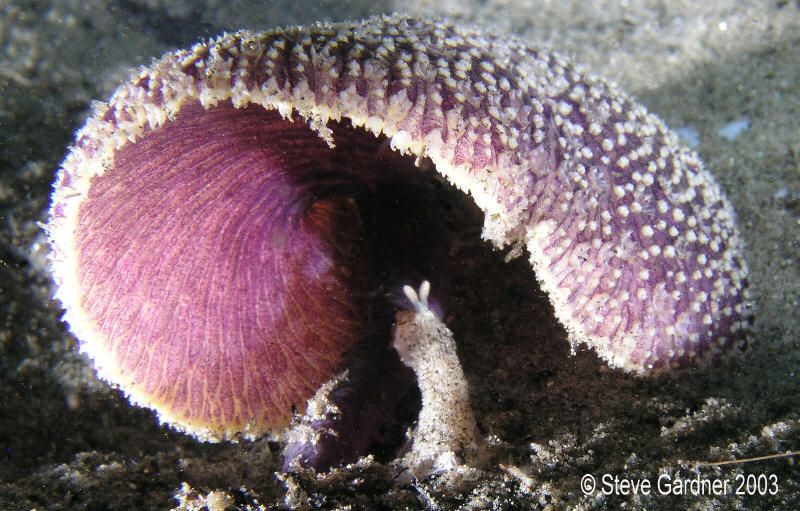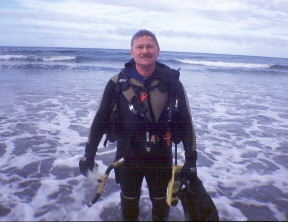 |
Armina californica
Photo couresty of Steve GardnerLa Jolla Shores, San Diego, Calif. Nov. 2003
Digital Photo
Armina californica Cooper, 1863
Arminids are one of those interesting opisthobranchs that really don't look like other members of the group and have been filed away taxonomically because - well - there really isn't any other place to put them. The old suborder Arminacea is sort of like that drawer in your kitchen where you toss all those odd items that don't fit nice and neat with the silverware (cutlery if you speak the Queen's English) and the salt and pepper.
Armina californica is a neat little creature with particularly noteworthy feeding habits. Webmaster Mike has featured this species as an Nudibranch of the Week twice before (1) (2) In fact, Armina is a sand bottom dweller. They are hard to find because they are usually either hiding under or covered with a thin layer of sand, and because they stay buried during the day, only coming to the surface to feed at night. Too bad too, because this species is actually pretty dramatic looking with its smart black and white stripes.
As mentioned in Hans' previous BOW's, this species feeds on sea pens, in particular Stylatula elongata, Ptilosarcus gurneyiand Renilla koellikeri. Renilla koellikeri, commonly called the sea pansy , adds to the colorful tale of this species because of an interesting behavior it has. The sea pansy, is one of the few sea pens that produces light on occasion. I am not really up to speed on the actual process by which the light is generated, but the polyps give of luminescent flashes of light when disturbed. Impossible to catch on film, although Steve sure tried here, the sea pansy produces a real light show when the Armina nips away at it.
References:
Bertsch, Hans. 1968. Effect of feeding by Armina californica on the bioluminescence of Renilla koellikeri. The Veliger, 10(4): 440-441.
Danville, Calif
Dec. 2003
Steve Gardner at La Jolla Shores

I asked Steve to give slug site readers an insight to his experience with his new Olympus 5050Z digital camera. The following is his reply: "... I have a Olympus 5050Z camera housed in a Ikelite Digital housing. Two Ikelite DS50 strobes were included with the TTL package. This system uses slave sensors to fire the strobes. There is no direct connection through the housing to the strobes. I shot the Armina californica photos in the Super Macro mode in Manual with the all time Auto Focus on. An F Stop setting of 8 (the highest setting available) at 100th of a second was used in conjunction with an ISO setting of 100. The Super Macro is really great and allows me to nearly touch the subject and still get the photo. If I were not using my two external strobes, I would not get an image as the onboard strobe gets blocked by the lens. Digital Photography is definitely challenging. I have had trouble getting the lighting right but I am improving. Having instant images displayed really helps in making changes to the lighting and composition ..."
Send Steve mail at stevebumblebee@san.rr.com |
Taxonomic information courtesy of:

David W. Behrens
Author:
Pacific Coast Nudibranchs
Send Dave mail at dave@seachallengers.com
|
